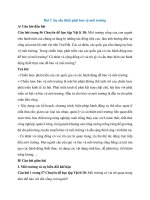Lecture Software process improvement: Lesson 9 - Dr. Ghulam Ahmad Farrukh
Bạn đang xem bản rút gọn của tài liệu. Xem và tải ngay bản đầy đủ của tài liệu tại đây (274.77 KB, 65 trang )
Intro to Process Management
Lecture # 9
1
Why is Important to Know Your
Current Process?
Pontificate on this point for a while
2
Technology Innovations
• Initially, new technology innovations and
improvements (languages, compilers,
CASE tools, and so forth) were viewed as
the “silver bullet”
• Technology helped, but it did not provide
the breakthrough desired
3
Deming’s approach
• Other industries began to adopt the
approach advocated by W. Edwards
Deming and successfully implemented by
many companies in Japan
• Deming’s approach, greatly influenced by
the work of Walter A. Shewhart, deals with
the notions of process management and
continual improvement
4
Deming’s approach
• Deming’s approach contends that to be
competitive, improve quality, and increase
productivity, the following actions are
required
5
Deming’s Approach 1
• Focus on the processes that generate the
products and services to improve quality
and productivity. Consider the task of
building the product or providing the
service as a series of integrated and
interconnected processes
• Ensure that the processes are properly
supported
6
Deming’s Approach 2
• Manage poorly behaving processes by
fixing the process, not blaming the people
• Recognize that variation is present in all
processes and that existence of variation is
an opportunity for improvement.
Improvement comes from reducing
variation
7
Deming’s Approach 3
• Take variation into account in the decision
making process. Management action uses
data from the process to guide decisions
8
ProcessThinking Principles
9
ProcessThinking Principles
• Requires unique relationship within the
organization, involving its management and
management philosophy, its people, and the
management of the processes used to
produce products and provide services
• How SW industry has adopted these
principles on the next slide
10
ProcessThinking Principles
• These concepts, methods, and practices
embody a way of thinking, a way of acting,
and a way of understanding the data
generated by processes that collectively
result in improved quality, increased
productivity, and competitive products
11
Processthinking Approach
• The acceptance and use of these process
thinking approach by much of the software
industry has required us to consider ways to
measure software processes that are
responsive to questions relating to process
performance (effectiveness, efficiency,
timeliness, predictability, improvements,
and product quality) in quantitative terms
12
Processthinking Approach
• A process is a sequence of steps performed
by people with the aid of tools and
equipment to transform raw material into
product
• Software process management is about
successfully managing the work processes
associated with developing, maintaining,
and supporting software products and
softwareintensive systems
13
Processthinking Approach
• This concept of process management is
founded on the principles of statistical
process control
• These principles hold that, by establishing
and sustaining stable levels of variability,
processes will yield predictable results
• Controlled processes are stable processes,
and stable processes enable you to predict
14
results
Processthinking Approach
• This, in turn, enables us to prepare
achievable plans, meet cost estimates, and
scheduling commitments, and deliver
required product functionality and quality
with acceptable and reasonable consistency
• If a controlled process is not capable of
meeting customer requirements or other
business objectives, the process must be
improved
15
Process Management
Responsibilities
• Define the process
• Measure the process
• Control the process
– Ensure variability is stable. Why? So that the
results are predictable
• Improve the process
16
Process Management
Responsibilities
Improve
Process
Define
Process
Control
Process
Measure
Process
Execute
Process
17
Defining the Process
• Defining a software process creates the
disciplined and structured environment
required for controlling and improving the
process
• Management’s responsibility to define each
process inherently includes responsibilities
for implementing and sustaining a process
18
Objectives of Process Definition
1
• Design processes that can meet or support
business and technical objectives
• Identify and define the issues, models, and
measures that relate to the performance of
the processes
• Provide infrastructures (the set of methods,
people, and practices) that are needed to
support software activities
19
Objectives of Process Definition
2
• Ensure that the software organization has
the ability to execute and sustain the
processes
–
–
–
–
–
Skills
Training
Tools
Facilities
Funds
20
Measuring the Process
• Measurements are the basis for detecting
deviations from acceptable performance
• They are also basis for identifying
opportunities for process improvement
21
Objectives of Process
Measurements 1
• Collect the data that measure the
performance of each process
• Analyze the performance of each process
22
Objectives of Process
Measurements 2
• Retain and use data:
– To assess process stability and capability
– To interpret the results of observations and
analyses
– To predict future costs and performance
– To provide baselines and benchmarks
– To plot trends
– To identify opportunities for improvements
23
Controlling the Process 1
• Controlling a process means keeping the
process within its normal (inherent)
performance boundaries – that is, making
the process behave consistently
• This involves
– Measurement
– Detection
– Correction
24
Controlling the Process 2
• Measurement
– Obtaining information about process performance
• Detection
– Analyzing the information to identify variations in the
process that are due to assignable causes
• Correction
– Taking steps to remove variation due to assignable
causes from the process and to remove the results of
process drift from the product
25









